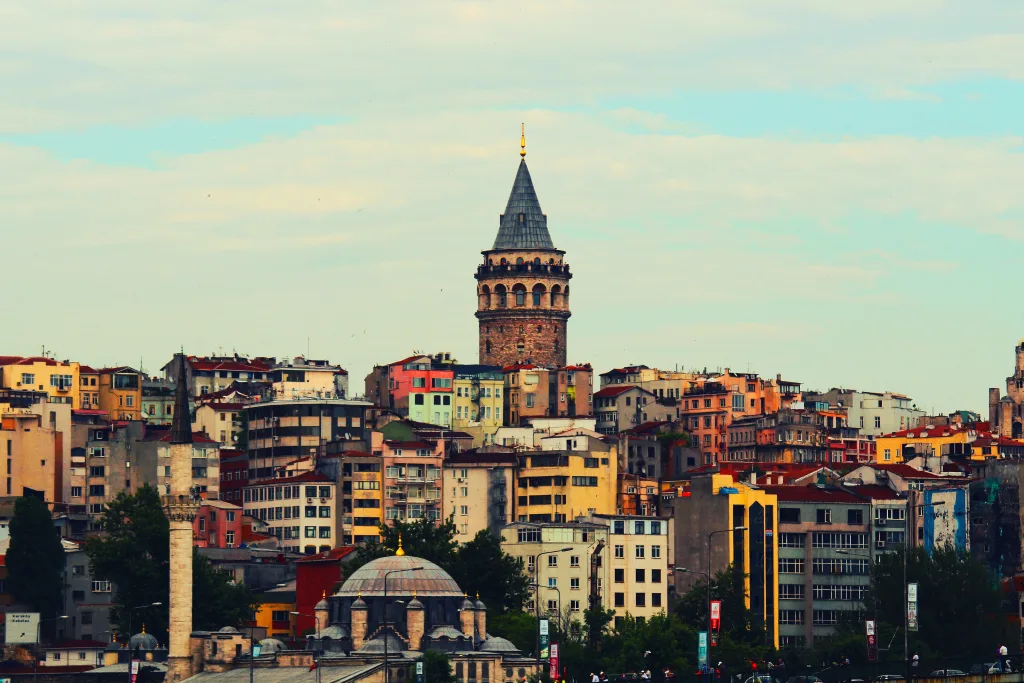Located in modern-day Turkey, Constantinople was an ancient city that served as the capital of both the Byzantine Empire and the Ottoman Empire. Situated on the European side of the Bosporus Strait, it straddled the borders of Europe and Asia, making it a significant cultural and economic hub.
Originally founded as Byzantion by Greek colonists in the 7th century BCE, the city was strategically positioned along the trade routes between the Black Sea and the Mediterranean. Its favorable location on the Bosporus Strait, which connects the Sea of Marmara to the Black Sea, made it an ideal spot for commerce and maritime activities.
In 324 CE, Emperor Constantine the Great chose Byzantion as the site for his new capital, renaming it Constantinople. This decision was influenced by the city’s strategic position, as well as its symbolic significance. Constantine saw himself as the successor to the Roman emperors and wanted to establish a new Rome in the east.
Constantinople’s location played a crucial role in its rise to prominence. The city was well-protected, surrounded by water on three sides and fortified with impressive walls. This made it practically impregnable, enabling it to withstand numerous sieges throughout its history. The city’s strong defenses were a testament to its importance as a political and economic center.
The strategic position of Constantinople also allowed it to control key trade routes. The Bosporus Strait, which ran through the heart of the city, served as a vital link between Europe and Asia. Merchants passing through Constantinople brought goods from all corners of the known world, making it a thriving center of commerce and cultural exchange.
The city’s location on the Bosporus Strait also made it a significant naval power. Its proximity to both the Black Sea and the Mediterranean allowed Constantinople to control maritime trade and project its influence across the seas. This naval supremacy further solidified its status as a major player in the region.
After the fall of the Byzantine Empire in 1453, Constantinople was conquered by the Ottoman Turks and became the capital of the Ottoman Empire. Under Ottoman rule, the city was renamed Istanbul and continued to serve as a vital center of trade and culture.
Today, Istanbul remains a vibrant and bustling metropolis, straddling the continents of Europe and Asia. Its location on the Bosporus Strait continues to shape its character, with stunning views of the sea and a unique blend of Eastern and Western influences.
Constantinople, now known as Istanbul, is located in modern-day Turkey and sits on the European side of the Bosporus Strait. Its strategic position at the crossroads of Europe and Asia made it a significant center of trade, culture, and political power throughout history.
Was Constantinople Roman Or Greek?
Constantinople was a city that had both Roman and Greek influences. It was originally founded as the Greek colony of Byzantion in the 7th century BC. However, in 324 AD, the Roman Emperor Constantine the Great decided to establish the city as the new capital of the Roman Empire and renamed it “New Rome.” This decision marked a significant shift in the city’s identity and solidified its Roman connection.
Under Roman rule, Constantinople became a thriving and cosmopolitan city, known for its impressive architecture, advanced infrastructure, and strategic location. It served as the political, economic, and cultural center of the Eastern Roman Empire, commonly referred to as the Byzantine Empire. The Romans heavily influenced the city’s governance, administration, and legal systems, shaping it into a distinctly Roman city.
However, despite its Roman designation, Constantinople also retained its Greek heritage. The Greek language and culture continued to flourish in the city, and Greek was widely spoken and used in various aspects of daily life. Greek scholars, philosophers, and artists played a significant role in shaping the intellectual and cultural atmosphere of Constantinople.
Constantinople can be considered both Roman and Greek. Its foundation as Byzantion was Greek, but its transformation into the capital of the Roman Empire by Constantine the Great established its Roman identity. Over time, the city developed a unique blend of Roman and Greek influences, making it a truly remarkable and culturally diverse metropolis.

Why Did Constantinople Become Istanbul?
Constantinople became Istanbul in 1453 due to the conquest of the city by the Turks, which marked the end of the Byzantine Empire and the beginning of the Ottoman Empire’s rule. The fall of Constantinople was the culmination of a 53-day siege, during which the Ottoman forces, led by Sultan Mehmed II, successfully breached the city’s defenses.
There were several factors that contributed to the fall of Constantinople and the subsequent renaming of the city. Here are some key reasons:
1. Weakened Byzantine Empire: The Byzantine Empire had been in a state of decline for centuries. It had lost significant territories to various invaders and struggled with internal conflicts, economic decline, and political instability. By the 15th century, the empire was a mere shadow of its former glory and lacked the resources and military strength to defend Constantinople effectively.
2. Ottoman Empire’s Expansion: The Ottoman Empire, under the rule of Sultan Mehmed II, had been steadily expanding its territories and influence. Constantinople was a strategic and coveted prize due to its location, wealth, and historical significance. The Ottomans had previously attempted to capture the city in 1394 and 1422 but were unsuccessful. However, in 1453, they were determined to conquer Constantinople and succeeded in doing so.
3. Siege and Breach of Constantinople: The Ottoman forces laid siege to Constantinople from April 6 to May 29, 1453. The siege involved a combination of land and sea attacks, with the Ottomans using advanced artillery and engineering techniques. Despite the valiant defense by the Byzantine forces, the city’s walls were eventually breached, leading to the collapse of its defenses.
4. Renaming of the City: After the conquest, Sultan Mehmed II officially declared Constantinople as the new capital of the Ottoman Empire and renamed it Istanbul. The origins of the name “Istanbul” are not entirely clear, but it is believed to have derived from the Greek phrase “eis tin polin” meaning “in the city” or “to the city.” Over time, Istanbul became the accepted name for the city, and it continues to be the name used today.
The fall of Constantinople and the renaming of the city marked a significant turning point in history. It not only ended the Byzantine Empire but also established Istanbul as the new capital of the powerful Ottoman Empire, which would go on to dominate the region for several centuries.
Is Constantinople In Greece Or Turkey?
Constantinople, also known as Byzantium in ancient times, is located in modern-day Turkey. It is not in Greece. Here are some key details about Constantinople:
1. Historical background: Constantinople was founded in 330 AD by the Roman Emperor Constantine the Great. It served as the capital of the Byzantine Empire, also known as the Eastern Roman Empire, for over a thousand years.
2. Strategic location: Constantinople occupies a strategic location on the European side of the Bosporus Strait, which connects the Black Sea to the Mediterranean Sea. This location made it a vital center for trade and military control.
3. Cultural and historical significance: Constantinople was a melting pot of various cultures, influenced by Roman, Greek, and Byzantine traditions. It played a crucial role in the development and preservation of classical Greek and Roman knowledge during the Middle Ages.
4. Ottoman Empire: In 1453, Constantinople was conquered by the Ottoman Turks led by Sultan Mehmed II, who renamed it Istanbul. It became the capital of the Ottoman Empire, which lasted until its dissolution in 1922.
5. Turkish Republic: After the fall of the Ottoman Empire, Istanbul became part of the newly established Turkish Republic in 1923. It remained the country’s largest city and a major economic and cultural hub.
Constantinople, now known as Istanbul, is located in Turkey, not Greece. It has a rich history, having served as the capital of both the Byzantine Empire and the Ottoman Empire. Its strategic location and cultural significance make it an important city in the region.
When Was Constantinople Renamed To Istanbul?
Constantinople, the renowned city that served as the capital of the Byzantine Empire, was officially renamed to Istanbul on March 28, 1930. This change in name occurred after the formation of the Turkish republic, which emerged from the remnants of the once-mighty Ottoman Empire. Istanbul is derived from the ancient Greek phrase “eis tēn polin,” meaning “to the city.” This renaming marked a significant shift in the city’s identity and reflected the cultural and political changes that took place in Turkey during that time.

Conclusion
Constantinople was located on the site of the Greek colony of Byzantion, which is now known as Istanbul in modern-day Turkey. It served as the capital of the Roman Empire when Emperor Constantine the Great declared it as the “New Rome” in 324. Over the centuries, Constantinople played a significant role as the capital of both the Byzantine Empire and the Ottoman Empire.
Today, Istanbul remains the largest city and principal seaport of Turkey. It is situated at the crossroads of Europe and Asia, making it a unique and strategic location both historically and geographically. With its rich history, diverse culture, and stunning architecture, Istanbul continues to be a major tourist destination and a symbol of the country’s vibrant past.
It is important to note that the renaming of Constantinople to Istanbul in 1930 marked a significant change in the city’s status after the fall of the Ottoman Empire. Istanbul, derived from the ancient Greek word for “the city,” reflects the city’s deep historical roots and its transformation into a modern metropolis that bridges continents.
